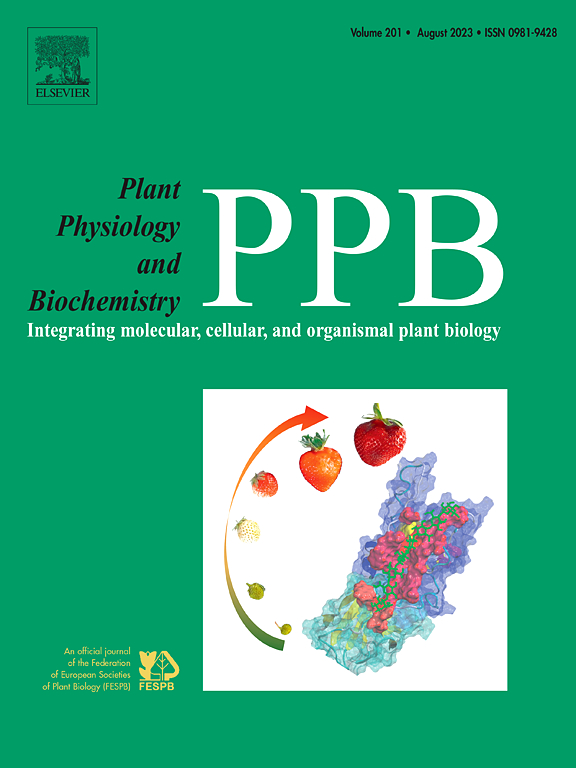Transcriptomic, metabolomic, and proteomic analyses reveal UVB-stimulated biosynthesis of flavonoids, terpenoids, and alkaloids in dandelion (Taraxacum officinale)
IF 5.7
2区 生物学
Q1 PLANT SCIENCES
引用次数: 0
Abstract
Ultraviolet-B (UVB) radiation acts as a natural environmental regulator that controls multiple physiological and metabolic processes in plants. Taraxacum officinale is a medicinal plant and dietary component that is notable for its abundance of bioactive secondary metabolites. To elucidate the response of secondary metabolites to UVB in T. officinale, we performed integrated transcriptomic, proteomic, and metabolomic analyses on leaf tissues following exposure to UVB for seven days. Transcriptomic analysis revealed a significant upregulation of genes associated with photosynthesis, flavonoid biosynthesis, and stress responses. Proteomic analysis identified upregulated proteins enriched in pathways related to secondary metabolite biosynthesis and alkaloid synthesis. Metabolomic profiling demonstrated a substantial increase in the accumulation of flavonoids, terpenoids, and alkaloids. Integrative network analysis further identified key transcription factors, including MYB, NAC, and bHLH, as central regulators of flavonoid, terpenoid, and alkaloid biosynthetic pathways in response to UVB exposure. Functional validation through transgenic overexpression in T. officinale demonstrated that ToMYB111, ToMYB113, and ToNAC068 act as positive regulators of flavonoid hyperaccumulation. Specifically, ToMYB113 and ToNAC068 transactivate the ToUGT1 promoter through direct binding, thereby enhancing flavonoid accumulation. These findings provide novel insights into the molecular basis of UVB-induced secondary metabolite accumulation in T. officinale, with potential applications in crop improvement and pharmaceutical development.
转录组学、代谢组学和蛋白质组学分析揭示了uvb刺激蒲公英(Taraxacum officinale)中黄酮类、萜类和生物碱的生物合成。
紫外线b (UVB)辐射是一种天然的环境调节剂,控制着植物的多种生理和代谢过程。蒲公英是一种药用植物和膳食成分,以其丰富的生物活性次生代谢物而闻名。为了阐明山药次生代谢物对UVB的反应,我们对暴露于UVB 7天后的山药叶片组织进行了综合转录组学、蛋白质组学和代谢组学分析。转录组学分析显示,与光合作用、类黄酮生物合成和胁迫反应相关的基因显著上调。蛋白质组学分析发现,与次级代谢物生物合成和生物碱合成相关的途径中富集了上调的蛋白质。代谢组学分析表明,黄酮类化合物、萜类化合物和生物碱的积累显著增加。综合网络分析进一步确定了关键转录因子,包括MYB、NAC和bHLH,它们是响应UVB暴露的黄酮类、萜类和生物碱生物合成途径的中心调节因子。ToMYB111、ToMYB113和ToNAC068是黄酮过度积累的正向调节因子。具体来说,ToMYB113和ToNAC068通过直接结合反激活ToUGT1启动子,从而促进类黄酮的积累。这些发现为了解uvb诱导的山药次生代谢物积累的分子基础提供了新的见解,在作物改良和药物开发方面具有潜在的应用前景。
本文章由计算机程序翻译,如有差异,请以英文原文为准。
求助全文
约1分钟内获得全文
求助全文
来源期刊
CiteScore
11.10
自引率
3.10%
发文量
410
审稿时长
33 days
期刊介绍:
Plant Physiology and Biochemistry publishes original theoretical, experimental and technical contributions in the various fields of plant physiology (biochemistry, physiology, structure, genetics, plant-microbe interactions, etc.) at diverse levels of integration (molecular, subcellular, cellular, organ, whole plant, environmental). Opinions expressed in the journal are the sole responsibility of the authors and publication does not imply the editors'' agreement.
Manuscripts describing molecular-genetic and/or gene expression data that are not integrated with biochemical analysis and/or actual measurements of plant physiological processes are not suitable for PPB. Also "Omics" studies (transcriptomics, proteomics, metabolomics, etc.) reporting descriptive analysis without an element of functional validation assays, will not be considered. Similarly, applied agronomic or phytochemical studies that generate no new, fundamental insights in plant physiological and/or biochemical processes are not suitable for publication in PPB.
Plant Physiology and Biochemistry publishes several types of articles: Reviews, Papers and Short Papers. Articles for Reviews are either invited by the editor or proposed by the authors for the editor''s prior agreement. Reviews should not exceed 40 typewritten pages and Short Papers no more than approximately 8 typewritten pages. The fundamental character of Plant Physiology and Biochemistry remains that of a journal for original results.

 求助内容:
求助内容: 应助结果提醒方式:
应助结果提醒方式:


